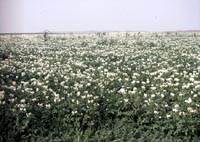Resource Library
Plant of the Week: Potato, Burbank
The University of Arkansas System Division of Agriculture does not promote, support or recommend plants featured in "Plant of the Week." Please consult your local Extension office for plants suitable for your region.
Plant of the Week
Burbank Potato
Latin: Solanum tuberosum 'Burbank'

Most home gardeners now have their "taters" planted and a few still plant the venerable
old "Burbank" selection.
In a world where plant cultivars have the staying power of teeny-bopper heart throbs,
this unique selection is a notable exception, as this summer the "Burbank" celebrates
its 125th year of commercial cultivation. On your next trip to the grocery, where
you will no doubt find mounds of the familiar brown baking potato piled high, take
a moment to pay homage to this most enduring vegetable.
The potato launched the plant breeding career of the nation’s most famous plant breeder,
Luther Burbank. In May1872, Burbank happened upon a ripening seed ball on an "Early
Rose" potato plant in his truck patch. From the berry, he grew 23 seedlings.
According to Burbank:
"Each of these plants yielded its own individual variations, its own interpretation
of long-forgotten heredity and numerous natural crossings. One, a beautiful, long
red potato, decayed almost as soon as dug; another was red-skinned with white eyes;
another white with red eyes; two white ones and several had eyes so deep that they
were unfit for use, and all varied widely."
He selected the two white-tubered plants and in 1875 sold his interest in the best
white potato to James J. H. Gregory, a seedman from Marblehead, Mass., for $150 instead
of the $500 Burbank was asking.
The seedman allowed Burbank to keep 10 tubers for his own use and did the honor of
naming the new potato the "Burbank." Burbank used the money to finance his move to
California, where he spent the rest of his life and developed his international fame.
Burbank is a fascinating historical figure that has had at least eight biographies
written about him, the most recent appearing in 1985. On a return visit to Massachusetts
after Burbank had gained some fame, he was asked what he would raise if he were farming
in that state. His reply: "I’d raise enough money to move to California."
The Burbank was an instant success because it was high yielding, uniform, of high
quality and it stored well. To that list can be added the fact it is a good processing
potato, important after WWII. By 1900, the commercial value of the Burbank potato
was $17 million annually.
While his original potato is still grown, its sport, "Russet Burbank," was the vegetable
that became the basis for the Idaho and Washington potato industry.
The sport originated in the field of Denver grower Leon Sweet in 1914. Idaho grows
30 percent of the nation’s potatoes and as late as 1989, this one potato claimed 98
percent of that state’s acreage.
In 1994, the state produced 13.8 billion pounds of potatoes on 408,000 acres. Since
then the share of the Russet Burbank has slipped to 79 percent, as other cultivars
have become popular with growers in an effort to broaden the market share during early
season August and September harvests.
In the South, potato cultivars such as the "Kennebec" -- a smooth oblong white --
or "Pontiac" -- the familiar round red potato -- are better choices than Burbank,
which requires a long growing season with warm days and cool nights to do its best.
A 10- foot row of potatoes will produce about 15 pounds of tubers but a real "meat
and tater" family may consume 75 to 100 pounds of potatoes per person per year.
Potatoes do best when planted in a rich, well drained garden soil with a pH below
5.6. Potatoes mature in about 110 days from planting the seed pieces.
By: Gerald Klingaman, retired
Extension Horticulturist - Ornamentals
Extension News - March 10, 2000
The University of Arkansas System Division of Agriculture does not maintain lists of retail outlets where these plants can be purchased. Please check your local nursery or other retail outlets to ask about the availability of these plants for your growing area.